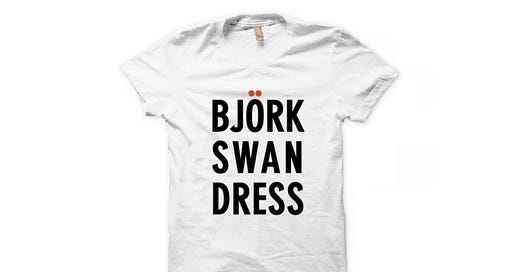Björk's Swan Dress vs. "Björk Swan Dress"
in search of smartdumb: Björk; Michael McGregor; new playlists
(6)
In 2001, the Icelandic artist Björk attended the Academy Awards in a dress that resembled a mute swan. It was lightly controversial in the media; the outfit was not typical of red carpet events. The dress, which was eventually revealed to be part of the artist’s album rollout, lived on as late-night show fodder, Halloween costuming, and other forms of parody. But as a cultural gesture, it was mere novelty - lightly amusing, ultimately frivolous. There is no before-swan dress / after-swan dress, except vis-a-vis Björk’s rising celebrity. I have found that many people, when they say they love Björk, have no history with the artist’s brilliant music or performances. They simply love the images of an Icelandic woman wearing that dress. Björk’s swan dress is an example of dumbdumb.
(7)
In 2016, the American artist Michael McGregor raised $472 on crowdfunding platform Kickstarter to print an edition of 20 t-shirts printed with the text “Björk Swan Dress.” “It’s an instant mental image maker,” explained the artist in his campaign. “The amazing thing is, it's probably the same mental image for everyone.” On first blush, the shirt appears to be no less a trifle than the thing it parodies. Upon closure inspection, there is the quiet elegance of the design, executed (I believe) by Chris Muccioli: the Ss curving not unlike the swan’s neck, the two red dots for unlauts that suggest eyes, the big O that suggests not just the dead swan’s surprise but ours as well. The shirt may conjour the same mental image for everyone, but it does not provoke the same reaction. It is a wearable Rorschach test – what? And how one reacts – Who? or Why? or Wow! – reveals more about them than about the dress, or the shirt, or the person wearing either. “Björk Swan Dress” is an example of smartdumb.
(8)
The smartdumb playlists at Spotify and Apple Music are now live. This week’s additions: Pauline Oliveros’s deep-listening masterpiece Accordion & Voice; Gavsborg’s exercise in phased looping and FM synthesis “Did Not Make This For Jah_9” (thank you Matthew Schnipper); and Bauhaus side project Tones on Tail’s “Go”, which was licensed for some show or movie I recently saw on Netflix, or Apple TV, or Hulu, though I can’t recall what or which.




